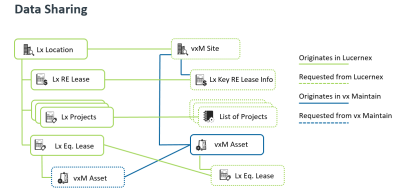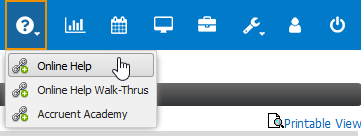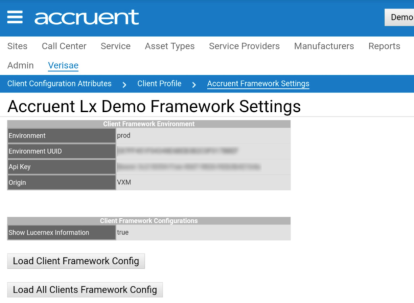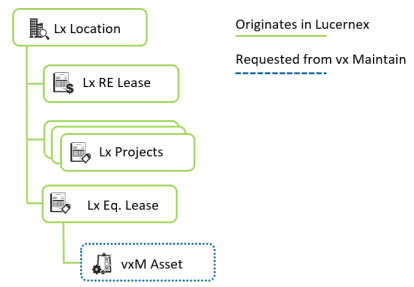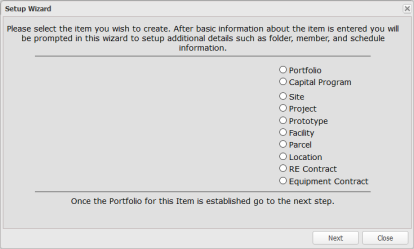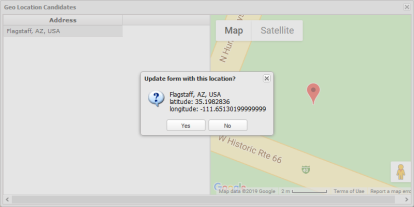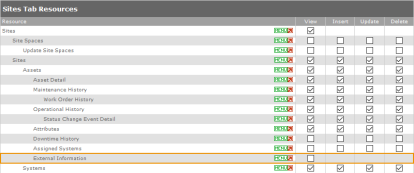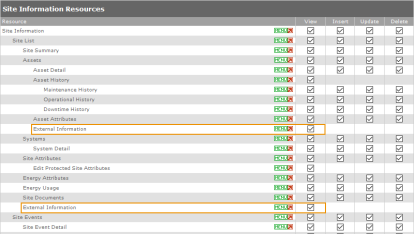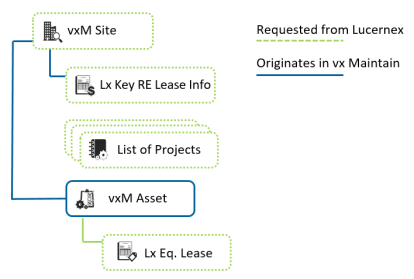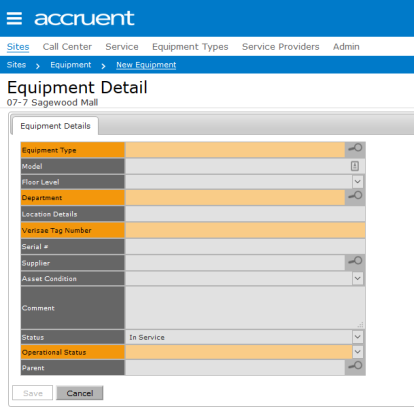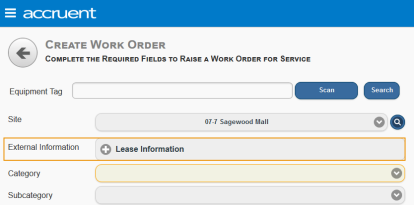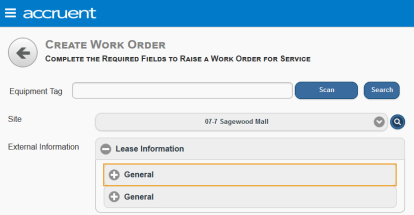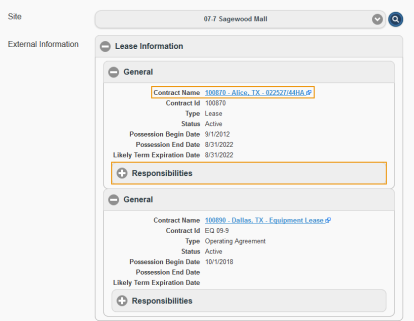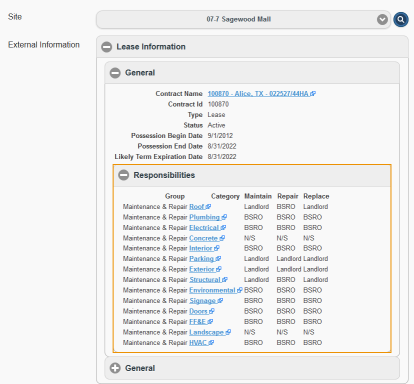Lucernex / vx Maintain integration
The Lucernex / vx Maintain integration provides an integrated workplace management solution that includes strong facility, project, and lease management modules. The integration aims to break down silos that are common in organizations. Organizational silos often make accessing data across teams challenging and time-consuming. As a result, work often becomes disconnected, manual, inefficient, and prone to mistakes.
This integration provides visibility into your portfolio and assists you in refining your management processes. By integrating Lucernex and vx Maintain, we are able to deliver the value of having the data you need in a single solution. With this integration, you will be able to see key lease and capital project data in vx Maintain and asset information in Lucernex.
This
 Products included
Products included
Lucernex is a best-in class, fully integrated portfolio lifecycle management solution that is backed by robust workflow and forms engines. Lucernex provides prolific data collection and regulatory compliance support. It can scale to thousands of concurrent projects, and can be used to monitor progress and costs across your portfolio.
vx Maintain is a best-in-class facility and asset management solution which can help you reduce waste across your maintenance life-cycle. vx Maintain helps you maximize the efficiency of your staff, maximize the uptime of your assets and facilities, and meet your compliance commitments. vx Maintain also provides data-driven performance analysis and asset management, and supports responsive business processes.
 Overview
Overview
In this integration, Lucernex is viewed as a the source of truth for all location, contract, and capital project data, and vx Maintain is the source of truth for all asset data. When a Location is created in Lucernex, a corresponding Site is created in vx Maintain. Your lease administrators and project managers can then create and manage contracts and capital projects associated with the location in Lucernex. The data associated with the location, contracts, and capital projects is read-only in vx Maintain.
Any assets associated with a location in Lucernex are created and managed in vx Maintain. These can include both leased and non-leased assets; however, you will only add leased assets to Lucernex. For example, in an office, you may lease a HVAC unit and own a refrigerator that is used in the break room. Both of these assets would be serviced using vx Maintain, but you would only add the HVAC unit to Lucernex because the HVAC unit is associated with an equipment contract.
Data sharing model in the Lucernex / vx Maintain integration.
 Key integration features
Key integration features
After implementation of the Lucernex / vx Maintain integration, the following features will be available:
-
Locations created in Lucernex will be pulled via API into vx Maintain. These locations will exist as sites in vx Maintain.
-
To learn how to create a location in Lucernex, see the Create a location in Lucernex section below.
-
-
Assets associated with a site in vx Maintain can be pulled by a Lucernex user and associated with an equipment contract.
-
To learn how to associate an asset from vx Maintain with an equipment contract in Lucernex, see the Add a vx Maintain asset to an equipment contract section below.
-
-
vx Maintain users can see Lucernex capital project, contract, and equipment contract information from the Site List page.
-
To learn how to view Lucernex capital project, contract, and equipment contract information from the Site List page, see the View site lease and capital project information from the Site List section below.
-
-
vx Maintain users can see Lucernex contract responsibility information from the Create Work Order page.
-
To learn how to view Lucernex contract responsibility information from the Create Work Order page, see the View responsibility information from the Create Work Order page section below.
-
The following functionality is NOT available at this time:
-
Cross-product reporting is not supported.
-
Single sign-on is not supported.
-
Assets already associated with an equipment contract are not filtered out from the Find Equipment modal window.
 Cross-product navigation
Cross-product navigation
In order for a user to access information from Lucernex in vx Maintain or from vx Maintain in Lucernex:
-
The user must have an account on both products.
-
All existing security requirements apply from both Lucernex and vx Maintain.
-
For applicable Lucernex permissions, see the Minimum user security settings - Lucernex section below.
-
For applicable vx Maintain permissions, see the Minimum user security settings - vx Maintain section below.
-
-
vx Maintain users must have the External Information setting applied to their user role.
To learn how to apply the External Information setting, see the Enable the External Information setting on a user role section below.
 Product documentation
Product documentation
Lucernex users can access product documentation in the Lucernex Online Help. The Lucernex Online Help can be accessed from the Help drop-down menu in the toolbar in the upper-right corner of the system.
Help drop-down menu.
vx Maintain users can access product documentation in the Verisae Documentation Wiki. For access to the Verisae Documentation Wiki, please contact the Verisae team.
As part of our commitment to delivering high-quality software, we will continue to expand and update our product documentation.
For additional help with the Lucernex / vx Maintain integration, please contact Accruent Support.
 Field mapping
Field mapping
The current field mapping for integrations is located in Confluence. This field mapping is updated with each integration.
-
To view the canonical form for assets, see the Assets Canonical Form page on Confluence.
-
To view the canonical form for locations, see the Locations Canonical Form page on Confluence.
 User work flow architecture
User work flow architecture
The following diagrams illustrate how information is passed in each key user work flow in the Lucernex / vx Maintain integration.
The above image displays the architecture of how information about Locations is delivered to vx Maintain in the integration.
The above image displays the architecture of how information about Assets is delivered to Lucernex in the integration.
The above image displays the architecture of how External Information is delivered to vx Maintain in the integration.
 Troubleshooting
Troubleshooting
The following table contains possible issues that users may encounter with the Lucernex / vx Maintain integration, and how to address these issues.
|
Issue |
Possible Source |
Resolution Path |
|---|---|---|
|
Integration Credentials missing, incorrect, or expired |
|
|
|
Locations aren’t syncing from Lucernex to vx Maintain |
|
vx Maintain Support reviews Lucernex Location, OR
|
|
Assets I need aren’t showing up in the Find Equipment modal window in Lucernex |
|
Check client search terms—search terms must exactly match asset name, OR
|
|
Lucernex Lease and / or Project data isn’t displaying in vx Maintain |
|
vx Maintain Support checks user permissions OR
|
 Enabling integration
Enabling integration
Prior to enabling the Lucernex / vx Maintain integration, you will need to enable the integration in Mulesoft. Mulesoft manages the API calls between Lucernex and vx Maintain. The steps to enable the integration must be performed in the order specified below:
-
Creating an integration user in Lucernex,
-
Retrieving the Lucernex authentication token,
-
Creating a Cross-Product Platform JIRA ticket, and
-
Enabling the integration in Lucernex and vx Maintain.
 Create an integration user in Lucernex
Create an integration user in Lucernex
To create an integration user in Lucernex, follow the steps below:
-
Log into the client firm in Lucernex.
-
Create an integration user with the System Administrator job function.
To learn how to create a member, see the Add a Person procedures on the Manage Members / Contacts Tab page of the Lucernex Online Help.
 Retrieve the Lucernex authentication token
Retrieve the Lucernex authentication token
To retrieve the Lucernex authentication token, follow the steps below:
-
Log into the client firm as the user you created in the Create an integration user in Lucernex procedures above.
-
Click the Admin button in the toolbar in the upper-right corner of the window.
The System Administrator Dashboard page opens.

Admin button in toolbar.
-
Click the RESTful WebService Docs link in the Data / PS Tools section.
The RESTful WebService Docs page opens.
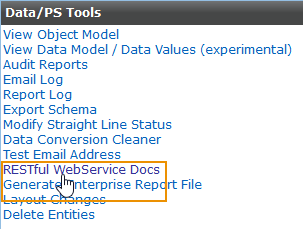
RESTful WebService Docs link.
-
Click the Copy RESTful Basic Authentication token to Clipboard button.
A dialog box opens.
-
Click your cursor in the field that appears in the dialog box.
-
Copy the authentication token.
-
Paste the authentication token somewhere you can refer back to it.
-
Click the OK button.
The dialog box closes.
Important!The authentication token you copied is necessary for the Cross-Product Platform JIRA ticket. It will be used for the Lucernex ID value mentioned in Step 6 of the Create a Cross-Product Platform JIRA ticket procedures below.
 Create a Cross-Product Platform JIRA ticket
Create a Cross-Product Platform JIRA ticket
Your first step will be to create a JIRA ticket which contains all the information necessary for the development team to link your client's Lucernex and vx Maintain environments using Mulesoft.
There is no method for retrieving an authentication token from vx Maintain. Instead, deliver the credentials for the vx Maintain integration user to the Integrations team.
Credentials should always be shared via LastPass. Reach out to the Integrations manager for instructions.
To create a cross-product platform JIRA ticket, follow the steps below:
-
Log into JIRA.
-
Click the Create button in the menu at the top of the page.
The Create Issue modal window opens.
-
Select Cross Product Platform (CPP) from the Project drop-down menu.
-
Select Story from the Issue Type drop-down menu.
-
Enter a descriptive title in the Summary field.
-
Enter the following information in the Description field:
-
Name — Enter the name of the client.
-
Products — List the integrated products for the client. For each product, this list will need to include:
-
ID — You will need an ID that is specific to the product and the client. This might also be called an authentication token.
Important!Each product has a unique method of generating an ID. See the sections above for product-specific procedures.
-
Name of the product
-
Origin code — Each product has a unique origin code.
For example, Lucernex's origin code is LX and vx Maintain's origin code is VXM. For a list of the existing origin codes, see the Clients Config page on Confluence.
-
-
Country — Specify the country where the client is based.
-
API Information —
Note:To get this information, reach out to the Engineering manager for the product.
-
Environment API URLs
-
Login API URLs
-
Credentials for APIs
Important!Credentials should always be shared via LastPass. Reach out to the Integrations manager in order to be granted access to the API credentials account.
-
-
-
Click the Create button.
The Create Issue modal window closes. The JIRA ticket is created.
Note:If you have questions about the status of your JIRA ticket, reach out to the Integrations manager.
 Enabling integration - Lucernex
Enabling integration - Lucernex
Once the client Mulesoft app has been deployed, you can enable the integration in Lucernex.
To enable the integration in Lucernex, follow the steps below:
-
Log into Lucernex.
-
Click the Admin button in the toolbar in the upper-right corner of the window.
The System Administrator Dashboard page opens.

Admin button in toolbar.
-
Click the Manage Company link in the Company Administration column.
The Manage Company page opens.
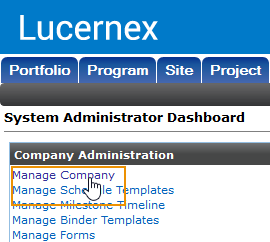
Manage Company Link.
-
Click the Integrations tab.
Note:This tab is only visible to Lx Administrators and PS Administrators.
-
Scroll down to the vxMaintain Integration subheading.
-
Click the Yes option button for the Enable vxMaintain Integration? setting.
-
Click the Update button at the bottom of the page.
The page refreshes. The vxMaintain Integration table is now populated with several keys.
Important!There is a setting in this table titled allowLxAssetCreation. Do NOT enable this setting without consulting with Product Management. This setting will break the integration unless it is used properly.
-
Scroll back down to the vxMaintain Integration subheading.
-
Find the environmentURL key in the vxMaintain Integration table.
-
Confirm that the value of the environmentURL key is one of the two following values:
-
If the value of the environmentURL key is NOT one of the values specified in Step 10, reach out to the Integrations manager.
 Enabling integration - vx Maintain
Enabling integration - vx Maintain
Once the client Mulesoft app has been deployed, you can enable the integration in vx Maintain.
To enable the integration in vx Maintain, follow the steps below:
-
Log into vx Maintain.
-
Select Client Configuration Attributes from the Verisae drop-down menu in the toolbar at the top of the page.
The Verisae Clients page opens.
-
Enter the name of the integration client in the Client Name search field at the top of the Verisae Clients table.
-
Click the Search button at the right side of the Verisae Clients table.
You can also press the Enter key on your keyboard.
The clients who match your search criteria appear in the table.
-
Click the name of the integration client.
The [Client Name] Master Attribute Subsets page opens.
-
Click the Client Profile link in the menu.
The Client Profile page opens.
-
Click the Accruent Framework item in the Client Profile table.
The Accruent Framework Settings page opens.
-
Click the Load Client Framework Config button.
The page refreshes. A Client Framework Environment table and a Client Framework Configurations table appear on the page.
Successful integration.
 Data sync scenarios
Data sync scenarios
This section will discuss how to approach scenarios when a client is new to one or both products in this integration.
Lucernex and vx Maintain have different requirements for locations and assets. There are fields that have been mapped that may be required for one product but not required for the other. Additionally, if a field is required in one product, the corresponding field in the other product may not be populated with data. In this scenario, those fields may need to be populated by the user or Professional Services prior to import.
 Lucernex customer, newly licensing vx Maintain
Lucernex customer, newly licensing vx Maintain
When an existing customer is newly licensing vx Maintain, follow the steps below:
-
When syncing Location data, leverage the existing vx Maintain Location request job built into the integration.
-
If the customer is tracking assets in the Lucernex Equipment Contract module, follow the steps below:
-
Export the asset records from Lucernex.
Include the following fields in your export:
-
Asset.UUID
Important!As of April 2019, Verisae does not support the import of UUIDs for assets. Therefore, after importing your asset records, you must then export the asset records with the UUID generated for the asset in Verisae and overwrite the UUID in Lucernex.
-
Asset.AssetName
-
Asset.AssetBarCodeNumber
-
Asset.CodeAssetTypeID
-
Asset.IntegrationAssetStatus
-
Asset.ManufacturerVendorID
-
Location.ClientEntityID
-
-
Import the asset records into vx Maintain.
-
 vx Maintain customer, newly licensing Lucernex
vx Maintain customer, newly licensing Lucernex
When an existing customer is newly licensing Lucernex, follow the steps below:
-
Export Verisae site records, and include the UUID in the export.
The following fields must be included. You may also include additional fields. If there is additional information from Verisae you want to import into Lucernex, please consult the Field mapping section above.
-
UUID
-
Status
-
Name
-
Longitude
-
Latitude
-
City
-
State
-
Postal Code
-
Country
-
Time Zone
Note:You will also need to add the Portfolio field to your import in order to associate the location with a portfolio.
-
-
Import the site records into Lucernex.
Note:From this point on, ongoing maintenance of site records must happen in Lucernex.
-
Prepare the equipment contract records in Lucernex.
-
Export the asset records associated with the equipment contracts from vx Maintain.
The following fields must be included. You may also include additional fields. If there is additional information from Verisae you want to import into Lucernex, please consult the Field mapping section above.
-
UUID
-
Status
-
Name
-
Asset Type
Note:You will also need to add the Equipment Contract IDfield to your import in order to associate the asset with an equipment contract.
-
-
Import the assets into Lucernex.
-
Going forward, add assets as needed using the Add a vx Maintain Asset to an Equipment Contract procedures below.
 New customer to both products
New customer to both products
If your customer is new to both Lucernex and vx Maintain, follow the steps below:
-
When syncing Location data, leverage the existing vx Maintain Location request job built into the integration.
-
Prepare the equipment contract records in Lucernex.
-
Create assets in vx Maintain.
-
Export the asset records associated with the equipment contracts from vx Maintain.
The following fields must be included. You may also include additional fields. If there is additional information from Verisae you want to import into Lucernex, please consult the Field mapping section above.
-
UUID
-
Status
-
Name
-
Asset Type
Note:You will also need to add the Equipment Contract ID field to your import in order to associate the asset with an equipment contract.
-
-
Import the assets into Lucernex.
-
Going forward, add assets as needed using the Add a vx Maintain Asset to an Equipment Contract procedures below.
 Lucernex
Lucernex
As mentioned above, in this integration Lucernex is viewed as a the source of truth for all location, contract, and capital project data. When a Location is created in Lucernex, a corresponding Site is created in vx Maintain. Your lease administrators and project managers can then create and manage contracts and capital projects associated with the location in Lucernex.
Every 15 minutes vx Maintain queries Lucernex for new and updated data.
 Minimum user security settings - Lucernex
Minimum user security settings - Lucernex
In order to view, create, edit, or delete data in Lucernex, an individual meet the following three criteria at a minimum:
-
The individual must have a user account created by their system administrator.
A member is any Lucernex user with a unique login ID and password. Before a member can have access to any part of a portfolio, you must first set up that member in your firm. This must only be done once for each Member.
To learn how to create a member, see the Add a Person procedures on the Manage Members / Contacts Tab page of the Lucernex Online Help.
-
The individual must have the appropriate permissions to view, create, edit, or delete the data they want to access.
Permissions are controlled by the user class of the member. The Member’s User Class determines which folders, documents, pages, fields, and actions within the portfolio that member may access.
To learn how to create and manage user classes, see the Manage Security section of the Lucernex Online Help.
-
The individual must meet one of two criteria:
-
They must have direct membership to a specific entity or entities.
Assigning a member to an entity gives them to access that particular entity. The member’s user class security settings determine what the member can see and do on the entity.
-
OR they must be a portfolio / program member and have appropriate user class security settings.
To learn how to add an individual as a member of an entity—including portfolios and programs—see the Add / Remove a Member from Selected Entities procedures on the One Member Many Projects Tab page of the Lucernex Online Help.
Important!We recommend managing membership on portfolios and programs and leveraging the Default Access to user class security settings in most cases. Following this recommendation will require less of your System Administrator’s time and your user security permissions will be easier to maintain. For example:
-
Flor’s user class has the View setting for the Default access to Contracts for Portfolio Members security setting.
-
Flor is a member of the Orchid portfolio and is not a member of any individual entities.
-
The Orchid portfolio has 4 projects, 10 facilities, and 10 contracts.
-
This means that Flor can view 10 contracts in Lucernex.
-
A Lease Admin adds a contract to the Orchid portfolio, meaning there are now 11 contracts in the portfolio.
-
Flor can now view 11 contracts in Lucernex.
If you have questions about when membership should be managed on individual entities, please contact your Professional Services team or Support.
Note:A member must be a member at the entity-level if they need to receive any type of entity-level notification.
-
-
 View-only user
View-only user
We recommend that you create a user class for employees who need view-only access to data.
The table below lists security items related to the Lucernex / vx Maintain integration. The table lists the minimum settings required to view data related to the integration. You may decide to give greater or fewer permissions than the ones listed in this section.
You can assume that any security setting not explicitly mentioned in this section is set to No Access.
|
Tab |
Security Item |
Setting |
|---|---|---|
|
Page Access |
Capital Project |
View |
|
Capital Project > Details |
View |
|
|
Capital Project > Details > Summary* |
View |
|
|
Capital Project > Details > Documents |
View |
|
|
Contract |
View |
|
|
Contract > Details |
View |
|
|
Contract > Details > Summary* |
View |
|
|
Contract > Details > Documents |
View |
|
|
Contract > Abstract Info |
View |
|
|
Contract > Abstract Info > Covenants |
View |
|
|
Contract > Abstract Info > Key Dates |
View |
|
|
Contract > Abstract Info > Responsibilities |
View |
|
|
Equipment Contract |
View |
|
|
Equipment Contract > Details |
View |
|
|
Equipment Contract > Details > Summary* |
View |
|
|
Equipment Contract > Details > Documents |
View |
|
|
Equipment Contract > Abstract Info |
View |
|
|
Equipment Contract > Abstract Info > Covenants |
View |
|
|
Equipment Contract > Abstract Info > Key Dates |
View |
|
|
Equipment Contract > Abstract Info > Responsibilities |
View |
|
|
List Layouts** |
View |
|
|
Sub-pages** |
View |
|
|
Actions |
Default access to Capital Projects for Program Members*** |
View |
|
Default access to Contracts for Portfolio Members *** |
View |
|
|
Default access to Equipment Contracts for Portfolio Members*** |
View |
|
|
Default access to Locations for Portfolio Members *** |
View |
|
|
Field Security |
Contract**** |
View |
|
Equipment / Assets**** |
View |
|
|
Equipment / Assets > General Information**** |
View |
*If your organization has created custom summary pages, open this folder and select the appropriate permissions for each summary page.
*The default summary pages typically contain payment information. Determine whether you want your view-only users to see this information. If you do not want them to see this information, you can revoke their view-access from the Field Security page.
**Users will only have access to list layouts and sub pages whose parent entity they have access to view, edit, or delete. This is because the List Layouts and Sub Pages page security settings are subordinate to the entity-level page access security settings.
***If you set the Default access for portfolio / program members for [EntityType] settings to View and add the person as a member to a portfolio or program, the users will have view-access to all entities of that entity type in the portfolio, assuming they have the appropriate page access.
****Users will only have access to fields whose parent entity they have access to view, edit, or delete. This is because the Field Security security settings are subordinate to the entity-level page access security settings. If there are specific fields you do not want users to view, find them within the folder structure and set them to No Access.
 Data hierarchy
Data hierarchy
Lucernex is divided into several modules which have parent / child and sibling / sibling relationships. The highest module in the hierarchy is the Portfolio. A Portfolio is the "umbrella" entity in the system—a portfolio is the first thing created when you begin using Lucernex, and all other entities in the system belong to a portfolio. A portfolio can be created for a brand, for a geographical area, or for any other system of classification.
The second level of the data hierarchy in Lucernex is the Location. The Location module is used to house physical information about locations in your portfolio, information about competitors, and your sales tax rate. Locations are parents to several other entity types, such as facilities, capital projects, leases, and equipment leases.
A capital project is a project which endeavors to modify an existing location. Capital projects are created and managed in the Capital Project module. Capital projects differ from projects, which are used when opening a new location. In this integration, project information is pulled from the Capital Project module.
The Contract module is used to manage your real estate leases, and the Equipment Contract module is used to manage your equipment leases. These two modules are very similar in function, with the key difference being that equipment contracts have another layer of functionality: assets. In this integration, assets will be created in vx Maintain and associated with an equipment contract.
The image below displays the Lucernex-half of the data hierarchy in the Lucernex / vx Maintain integration. For the full diagram, see the Overview section above.
This image depicts the Lucernex half of the Lucernex / vx Maintain integration.
 Integration-specific procedures
Integration-specific procedures
This section contains procedures that are specific to the integration in the Lucernex application.
 Create a location in Lucernex
Create a location in Lucernex
Depending upon how your firm is configured, the Location Setup Wizard may have additional fields that are required. These procedures describe the minimum settings required in the Location Setup Wizard for the Lucernex / vx Maintain integration to function properly.
Every quarter of an hour, vx Maintain queries Lucernex for new or updated data.
To create a location in the Lucernex / vx Maintain integration, follow the steps below:
-
Log into Lucernex.
-
Choose between two options:
-
To open the Location Setup Wizard from the Summary page of the Location module, follow the steps below:
-
Navigate to Location > Details > Summary using the tabs in the menu at the top of the page.
-
Click the Add Location button in the Actions menu on the right side of the page.
The first step of the Location Setup Wizard opens.
-
-
To open the Location Setup Wizard from the Tools menu, follow the steps below:
-
Click the Tools button in the toolbar in the upper-right corner of the window.
Tools button in toolbar.
-
Select Setup Wizards from the drop-down menu that appears.
The Setup Wizard modal window opens.
Setup Wizard modal window.
-
Select the Location option button.
-
Select the portfolio you want this location to belong to from the drop-down menu that appears above the entity option buttons.
-
Click the Next button.
The first step of the Location Setup Wizard opens.
-
-
-
Complete the following required fields:
-
Portfolio — Select the portfolio that this location belongs to from this drop-down menu.
A Portfolio is the "umbrella" entity in the system—a portfolio is the first thing created when you begin using Lucernex, and all other entities in the system belong to a portfolio. A portfolio can be created for a brand, for a geographical area, or for any other system of classification.
-
Status — Select the status of the location from this drop-down menu. The Lucernex Location status must be marked as Active for the location to be active in vx Maintain.
-
Name — Enter the name of the location in this field.
-
Region — Select the region that this location belongs to from this drop-down menu. Regions are subcategories that belong to your portfolio's organizational chart.
-
Longitude — self-explanatory.
-
Latitude — self-explanatory.
 Click here to learn how to automatically populate the latitude and longitude of your location
Click here to learn how to automatically populate the latitude and longitude of your location
To have the system automatically calculate the location's latitude and longitude, follow these steps:
-
Populate as much address information as you can in the provided Address fields.
-
Click the Geocode button
 to the right of either the Longitude or Latitude fields.
to the right of either the Longitude or Latitude fields.The Geo Location Candidates modal window opens.
-
Click the appropriate address in the Address table.
A dialog box opens, asking you to confirm your choice.
Geo Location Candidates modal window.
-
Click the Yes button.
The dialog box and the modal window close. The Longitude and Latitude fields are populated.
-
-
City — self-explanatory.
-
State — self-explanatory.
-
Zip — self-explanatory.
-
Country — self-explanatory.
-
Time Zone — self-explanatory.
-
-
Click the Next button.
The Folder Set-up page of the Location Setup Wizard opens.
-
Select the folder template you want to use for your location from the Location folder template drop-down menu.
-
Click the Next button.
The Assign Members page of the Location Setup Wizard opens.
Assigning a member allows that member to access specific folders, documents, pages, fields, and actions within the location. A member is any Lucernex user with a unique login ID and password. Before a member can have access to any part of a location, you must first set up that member in your firm. This must only be done once for each Member.
Once a Lucernex user is set up as a Member of your Firm, they must be added to each location and assigned user classes. The Member’s User Class determines which folders, documents, pages, fields, and actions within the location that member may access.
-
To learn how to set up and configure members in your firm, see the Minimum user security settings section above.
-
To assign members to a location, follow the steps below:
-
Click the Assign Members button.
A new page opens.
-
Choose between two options:
-
To add all members in the system, click the Add all members button in the upper left corner of the Members NOT Assigned table.
All members currently configured in your system are added to the Current / Proposed member (s) field.
-
To search for a specific member to add to your location, follow the steps below:
-
Enter the name of the member you want to assign in the Search field at the upper right corner of the Members NOT Assigned table.
-
Click the Search button.
The members meeting your search criteria appear.
-
Click the
 button next to the member you want to add.
button next to the member you want to add.The member is added to the Current / Proposed member (s) field.
-
-
-
If you need to remove a member from the Current / Proposed member (s) field, follow the steps below:
-
Select the member you want to remove.
Note:Press and hold the CTRL button on your keyboard to select multiple values.
-
Click the Remove Selected button below the Current / Proposed member (s) field.
The member is removed from the Current / Proposed member (s) field.
-
-
Once you are satisfied with your list, click the Update members to [Location Name] button.
-
Click the Finish Assigning Members button at the bottom-right corner of the Location Setup Wizard.
The Assign Members page opens. The members you assigned appear in the Managers and Members already assigned using Org Chart table.
-
-
Click the Next button.
The Schedule Set-up page of the Location Setup Wizard opens.
-
If you want to apply a schedule template to your location, follow the steps below:
-
Select the template you want to use from the drop-down menu.
-
Enter (or click the Calendar button
 to open the Date Picker and select) the start date of your schedule in the Start On field.
to open the Date Picker and select) the start date of your schedule in the Start On field. -
Enter (or click the Calendar button
 to open the Date Picker and select) the end date of your schedule in the End On field.
to open the Date Picker and select) the end date of your schedule in the End On field.
-
-
Click the Finish button.
The Location Setup Wizard closes. Your location is now saved in the system.
 Add a vx Maintain asset to an equipment contract
Add a vx Maintain asset to an equipment contract
The Find Equipment modal window does not filter out assets that have already been added to an equipment contract. This functionality is slated for a future release.
The Find Equipment modal window will display all assets associated with a location. Only add leased assets to your equipment contract.
To add an asset to an equipment contract, follow the steps below:
-
Log into Lucernex.
-
Navigate to Equipment Contract > Details > Summaryusing the tabs in the menu at the top of the page.
-
Click the Edit button in the Actions menu on the right side of the page.
The page becomes editable.
-
Scroll down to the Assets table.
-
Click the Find Equipment button.
The Find Equipment modal window opens.
Find Equipment modal window.
Note:When the Find Equipment modal window first opens, it will not populate with any asset data. This is because there is a potential for a significant number of assets.
-
Choose between two options:
-
Type the name of the location the asset is associated with in the Location field.
-
Type the name of the asset in the Asset field.
Important!You must type the name of the location or the asset EXACTLY as it appears in the system, including capital letters.
-
-
Click the Search button to the right of the Asset field.
The modal window populates with the assets that meet your search criteria.
Note:Once the user requests equipment information in Lucernex, Lucernex will call Mulesoft. Mulesoft will then call vx Maintain for equipment information. vx Maintain will deliver the equipment information to Mulesoft, which is then delivered to the user in Lucernex.
Important!The Find Equipment modal window does not filter out assets that have already been added to an equipment contract. This functionality is slated for a future release.
Assets in the Find Equipment modal window.
-
Select the check box to the left of each asset you want to add to the equipment contract.
Note:You can also select the check box in the Select column header to select all assets in the table.
-
Click the Add Selected Assets button.
Lucernex begins to add the assets to your equipment contract. Once the assets have been added, the modal window closes. The assets appear in the Assets table.
 Create a new Asset in vx Maintain
Create a new Asset in vx Maintain
You can quickly access the page used to create a new asset from the Find Equipment modal window.
To access the Equipment Detail page in vx Maintain from Lucernex, follow the steps below:
-
Log into Lucernex.
-
Navigate to Equipment Contract > Details > Summary using the tabs in the menu at the top of the page.
-
Click the Edit button in the Actions menu on the right side of the page.
The page becomes editable.
-
Scroll down to the Assets table.
-
Click the Find Equipment button.
The Find Equipment modal window opens.
Find Equipment modal window.
-
Click the Create Asset button.
A new tab opens. Your browser will prompt you to log into vx Maintain. When you log in to vx Maintain, the Site List page opens. Follow the Create Assets / Equipment in vx Maintain procedures below to continue the process of creating a new asset in vx Maintain.
 vx Maintain
vx Maintain
As mentioned above, once a location is created in Lucernex, vx Maintain will automatically create and update a corresponding site record. These records are updated every quarter of an hour. Once the site record is created in vx Maintain, you can view contract and capital project data associated with the site. Additionally, you can also create assets associated with the site in vx Maintain. These assets will include both leased and non-leased equipment; however, you will only add leased assets to Lucernex.
For example, in an office, you may lease a HVAC unit and own a refrigerator that is used in the break room. Both of these assets would be serviced using vx Maintain, but you would only add the HVAC unit to Lucernex because the HVAC unit is associated with an equipment contract.
 Minimum user security settings - vx Maintain
Minimum user security settings - vx Maintain
In order to view, create, edit, or delete data in vx Maintain, an individual meet the following three criteria at a minimum:
-
The individual must have a user account created by an administrator.
Client users are typically created by client administrators, while provider users are either created by Accruent Support or a provider administrator. A user must have a unique user name and password.
-
The individual must have a role assigned to their user account.
A user's role controls their security rights. Roles are defined by Verisae admins and are associated with clients. Roles control view-access to all pages in the application as well as add / edit / delete permissions. There are separate resources for both the workspace and the mobile dashboard.
-
The user account must have a client filter, a provider filter, a location filter, or some combination of one or more filters.
-
Client filters limit user access to the data of one or more clients.
-
Provider filters limit user access to the data of the provider they work for.
For example, a maintenance company contracted by a grocery store.
-
Location filters limit user access to the data of their assigned location.
-
 Enable integration settings on a user role
Enable integration settings on a user role
To quickly find settings on the Role Detail page, follow the steps below:
-
Press the CTRL and F keys on your keyboard.
-
Enter the name of the setting in the Find field that opens.
-
Press the Enter key on your keyboard.
Your computer navigates you to the setting.
-
Repeat steps 2-3 to find other relevant settings.
You will need to enable these settings for both workspace and mobile users.
To enable the External Information setting on a user role, follow the steps below:
-
Log into vx Maintain.
-
Select Roles from the Verisae drop-down menu in the toolbar at the top of the page.
The Roles page opens.
-
Select the role you want to edit from the Roles table.
The Role Detail page opens.
-
Scroll down to the Sites Tab Resources table.
-
Select the View check box for the Sites > Assets > External Information setting.
Sites > Assets > External Information setting. This setting appears below the Assigned Systems setting and above the Systems setting.
-
Select the View check box for the Sites > Sites > External Information setting.
Sites > Sites > External Information setting. This setting appears below the Site Space Detail setting and above the Schematics & Photos setting.
-
Scroll down to the External Resources table.
-
Select the View check box for the Lucernex setting.
Lucernex setting in the External Resources table.
-
Click the Save button in the lower-right corner of the page.
The Roles page opens. Your changes are saved.
-
Repeat steps 3 - 9 for any additional roles to which you want to give the External Information setting.
 Enable integration settings for mobile roles
Enable integration settings for mobile roles
To quickly find settings on the Mobile Role Detail page, follow the steps below:
-
Press the CTRL and F keys on your keyboard.
-
Enter the name of the setting in the Find field that opens.
-
Press the Enter key on your keyboard.
Your computer navigates you to the setting.
-
Repeat steps 2-3 to find other relevant settings.
You do not need to enable these settings for user roles that will not be using the Mobile Dashboard.
If users will be accessing the vx Maintain Mobile Dashboard, you will also need to enable some settings on the Mobile Role Detail page for their role.
To enable integration settings for a role that will be using the Mobile Dashboard, follow these steps:
-
Log into vx Maintain.
-
Select Roles from the Verisae drop-down menu in the toolbar at the top of the page.
The Roles page opens.
-
Select the role you want to edit from the Roles table.
The Role Detail page opens.
-
Click the Mobile Role Detail link in the Roles menu.
Mobile Role Detail link.
-
Scroll to the Site Information Resources table.
-
Select the View check box for the Site Information> Site List > Assets > External Information setting.
-
Select the View check box for the Site Information> Site List > External Information setting.
External information settings.
-
Click the Save button in the lower-right corner of the page.
The Roles page opens. Your changes are saved.
-
Repeat steps 3 - 8 for any additional roles.
 Data hierarchy
Data hierarchy
A Site is the highest level entity in vx Maintain. A site is the physical location, building, address, or campus. In this integration, sites in vx Maintain have a 1-1 ratio with locations created in Lucernex. Lucernex is the single source of truth for site data. A site is often broken down into smaller subcategories—each site can have one or more floor levels, and each floor level can have one or more departments or spaces.
A Department can be used to break down a site into more manageable sections. Departments are often used to categorize sites into subsections that have a common functional theme. A common example of how the department function is used in vx Maintain is the departments of a grocery store—for example, you could break a grocery store into dairy, produce, meat, and bakery departments. You also have the option of associating one or more spaces with a department.
A Space is another method of breaking down a site. Spaces have physical boundaries that relate to the floor plan of the site—for example, a space in a hotel could be a hotel room or conference room. vx Maintain also allows users to create basic schedules related to spaces. Most clients will create one space in vx Maintain per floor plan space. When creating a space, you have the option of associating the space with a department.
You can also associate equipment with a site. Equipment can be broken down into four levels of categorization: category, sub category, asset type, and asset. An example of how this categorization could be applied is as follows:
-
Category — HVAC
-
Sub Category — Furnaces
-
Asset Type — 10-ton air handling unit
-
Asset — model # FN0032771
In this integration, vx Maintain is considered the single source of truth for asset data.
The image below displays the vx Maintain-half of the data hierarchy in the Lucernex / vx Maintain integration. For the full diagram, see the Overview section above.
This image depicts the vx Maintain half of the Lucernex / vx Maintain integration.
 Integration-specific procedures
Integration-specific procedures
This section contains procedures that are specific to the integration in the vx Maintain application.
 Create assets / equipment in vx Maintain
Create assets / equipment in vx Maintain
To create assets / equipment in vx Maintain, follow the steps below:
-
Log into vx Maintain.
-
Select Sites from the Sites drop-down menu in the toolbar at the top of the page.
The Site List page opens.
-
Select the appropriate site from the Site List table.
The Site Equipment page opens.
-
Click the New button at the bottom-left corner of the Site Equipment table.
The Equipment Detail page opens.
Equipment Detail page.
-
Click the Search button to the right of the Equipment Type field.
The Equipment Type modal window opens.
-
Select the equipment type from the Equipment Type table.
The selected equipment type row will have an orange background color.
-
Click the Select button.
The modal window closes. The equipment type appears as selected in the Equipment Type field.
-
Enter the model name of the equipment in the Model field.
-
Select the floor where the equipment is located from the Floor Level drop-down menu.
-
Click the Search button to the right of the Department field.
The Department modal window opens.
-
Select the department from the Department table.
The selected department row will have an orange background color.
To learn more about departments, see the Data hierarchy section above.
-
Click the Select button.
The modal window closes. The department appears as selected in the Department field.
-
Enter any details about the location in the Location Details field.
-
Enter the Verisae tag number in the Verisae Tag Number field.
Note:The Verisae Tag Number field is used to notate the bar code number associated with the asset. This code can be provided by the Verisae team, or it can be generated using your own bar code system.
-
Enter the serial number of the equipment in the Serial # field.
-
Click the Search button to the right of the Supplier field.
The Supplier modal window opens.
-
Select the supplier from the Supplier table.
The selected supplier row will have an orange background color.
-
Click the Select button.
The modal window closes. The supplier appears as selected in the Supplier field.
-
Select the condition of the equipment from the Asset Condition drop-down menu.
Example conditions include Like New, Used, and Needs Replacement.
-
Enter any comments about the equipment in the Comment field.
-
Select the status of the equipment from the Status drop-down menu.
The value of the Status field is configurable with internally-defined status values. Examples include in-service, sold, scrapped, or in storage.
-
Select the operational status of the equipment from the Operational Status drop-down menu.
The value of the Operational Status field corresponds with whether the asset is functional or non-functional.
-
Click the Search button to the right of the Parent field.
The Equipment modal window opens.
-
Select the parent equipment from the Equipment table.
The selected equipment row will have an orange background color.
Note:Assets can be split into sub-assets for the purposes of allocating repairs and replacements. For example, the parent asset could be an HVAC unit, while its child asset could be a compressor or condenser coil.
-
Click the Select button.
The modal window closes. The equipment appears as selected in the Parent field.
-
Click the Save button.
The system returns you to the Site Equipment page. The equipment you created appears in the Site Equipment table.
Note:Once the user requests equipment information in Lucernex, Lucernex will call Mulesoft. Mulesoft will then call vx Maintain for equipment information. vx Maintain will deliver the equipment information to Mulesoft, which is then delivered to the user in Lucernex.
 View site lease and capital project information from the Site List
View site lease and capital project information from the Site List
To view lease and capital project information from the Site List page, follow the steps below:
-
Log into vx Maintain.
-
Select Sites from the Sites drop-down menu in the toolbar at the top of the page.
The Site List page opens.
-
Select the appropriate site from the Site List table.
The Site Equipment page opens. New options appear in the Sites menu.
-
Click the External Information link in the Sites menu.
The External Information page opens.
External Information link.
-
Select one of two options from the drop-down menu:
-
Show Project Information
-
Show Lease Information
-
-
Click the Submit button.
-
If you selected Show Project Information, a list of capital projects appears on the page. The name of each project is hyperlinked. Clicking the hyperlink will open the project in Lucernex.
Show Project Information page.
-
If you selected Show Lease Information, a list of contracts and equipment contracts appears on the page. The contract names and responsibility categories are hyperlinked. Clicking the hyperlinks will open the contract, equipment contract, or responsibility in Lucernex.

Show Lease Information page.
Note:This information is also available in the Mobile app on the External Information tab on the Site Summary page.
-
 View responsibility information from the Create Work Order page
View responsibility information from the Create Work Order page
To view site responsibility information in vx Maintain from the Create Work Order page of the Mobile Dashboard, follow the steps below:
-
Log into vx Maintain.
-
Open your Dashboard.
You can access your Dashboard by clicking the menu button to the left of the Accruent logo in the upper-left corner of the page.
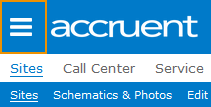
The Menu button.
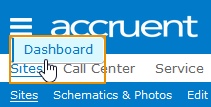
After clicking the Menu button, a link to the Dashboard appears.
-
Click the Create Work tile.
The Create Work Order page opens.
-
Select the site from the Site drop-down menu.
vx Maintain loads a new section labeled External Information. This section contains an expanding section labeled Lease Information.
External Information section.
-
Click the Expand button
 to the left of the Lease Information section.
to the left of the Lease Information section.One or more additional expanding sections will appear in the External Information section. These expanding sections have the label General, and they contain information related to contracts and equipment contracts on the site.
General expanding sections, closed.
-
Expand the General expanding sections in the Lease Information section.
The General sections open and contain basic information about the associated contracts.
-
The name of the contract or equipment contract is hyperlinked. This hyperlink will take you to the contract or equipment contract in Lucernex.
-
In each General section there is a Responsibilities section. This section lists the responsibilities associated with the contract or equipment contract.
The General expanding sections, opened. In the screen shot above, the hyperlinked Contract Name and Responsibilities expanding section are boxed in orange.
-
-
Expand the Responsibilities expanding section to view the lease responsibilities.
Responsibilities expanding section.
-
To view a responsibility on a contract or equipment contract in Lucernex, click the hyperlinked responsibility name in the Category column.

In this screen shot, the user is about to click the hyperlink to the roof responsibility record in Lucernex.
Lucernex opens to the responsibility in a new tab.
The responsibility record in Lucernex.
